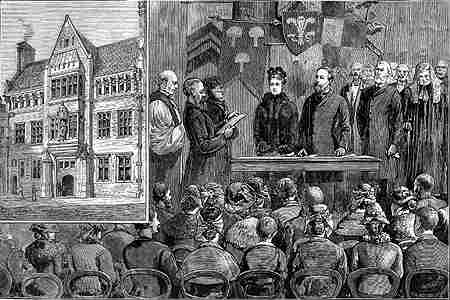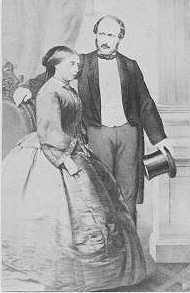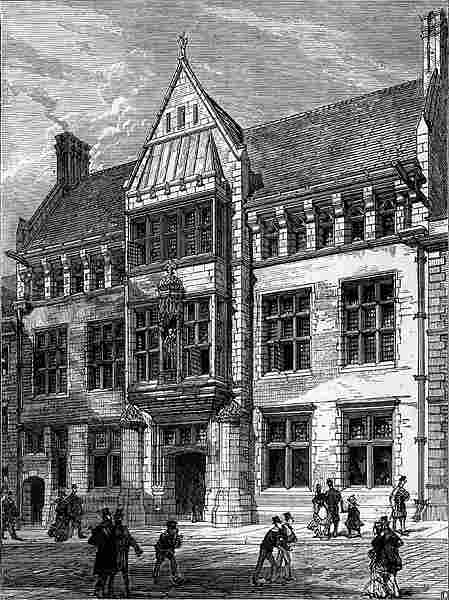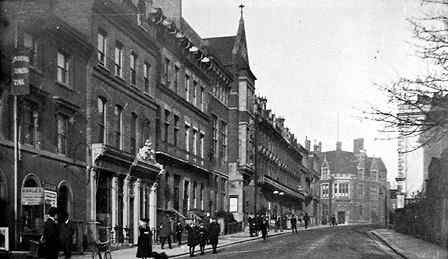
Sheet Street, Windsor |

Sheet Street, Windsor |

The Prince of Wales opened the new building of the Albert Institute of Windsor and Eton last Saturday. The Windsor and Eton Mechanics Institute has existed many years. The edifice, in Sheet Street, Windsor, of which an illustration is given, has been named in memory of the lamented Prince Consort. Its construction, and the subscription of funds to pay for it, were chiefly promoted by the efforts of a committee, including the honorary secretary Mr. F. B. Buckland, the Rev. F. J. Rawlins, Dr. Fairbank, Captain Bulkeley, Sir George Elvey, Doctor of Music, Mr. R. Richardson-Gardner, M.P., Mr. Drew, of Eton College, and the Mayor of Windsor. The architects are Messrs. H. F. Bacon and E. Ingress Bell, of London. The building has a frontage of 70ft., and is in the later Tudor style, harmonising with other Windsor and Eton buildings. It is constructed of red brick with stone dressings and mullions, and is roofed with reddish brown tiles. Mr. Woodbridge, of Maidenhead, was the builder. There are three storeys, comprising a large hall for lectures, meetings, and entertainments, with retiring rooms, a library, reading room, ladies' reading room, museum, classrooms, committee rooms, and apartments for the keeper. In a niche over the main entrance will be placed a marble statue, by Romanelli of the late Prince Consort, which is the gift of Mrs. Richardson-Gardner. The entrance hall contains a memorial tablet, stating that the institute is designed "to aid the pursuit of knowledge and .art so loved by him." Prince Christian, on behalf of his wife, Princess Helena, laid the memorial stone in honour of her father, on March 28, last year.  with Queen Victoria The opening ceremony last Saturday was performed in a successful manner. The Prince of Wales, accompanied by Prince and Princess Christian of Schleswig-Holstein who came from Cumberland Lodge. They were received by the committee, with the Bishop of Oxford and the Dean of Windsor. The united choirs of St George's Chapel, Windsor, and of Eton College Chapel, with a string band composed of men of the 2nd Life Guards performed a special Cantata under the direction of Sir George Elvey. An address was presented to the Prince of Wales, and His Royal Highness made a suitable reply. The president of The Institute, Captain Bulkeley, was unfortunately absent from ill health. A benediction was pronounced by the Bishop and the Prince declared the opening of the new building. His Royal Highness went over it, with the committee, and then returned to London.  This engraving from the Illustrated London News of January 17th 1880 In 'The Graphic' magazine, also published on January 17th 1880, it is reported that The Prince of Wales, during his visit to Prince and Princess Christian at Cumberland Lodge, hunted with Mr. Garth's foxhounds. The Duke of Connaught and Strathearn and Prince Christian also joined the meet, which was at Haines Hill, near Twyford, the seat of the master of the pack. Their Royal Highnesses lunched with Mr. Garth, and afterwards, accompanied by the 'field,' which numbered 150, trotted out of the park to Charity Wood, Billingbear, where the coverts were drawn, the chase leading away in the direction of Binfield. The Princes at the close of the day's sport returned to Cumberland Lodge. The Prince also during his stay shot through the preserves in Windsor Great Park. On Saturday his Royal Highness opened the Albert Institute at Windsor, an illustration of which is given in this issue. [See above. Ed.] The Prince arrived at Marlborough House in the evening, and left on Monday for Hughenden, on a visit to the Earl of Beaconsfield. Marshall's Guide to Windsor dating from the earliest years of the reign of George V, features the following description. THE ROYAL ALBERT INSTITUTEThis handsome building was erected as a
memorial to the late Prince Consort, at a cost of about £6,000.
It is situate in Sheet Street, and is constructed of red brick
with stone dressings, in the style of the English gothic architecture
of the 15th century. It has a frontage of 90 feet, and contains
a: large Concert or Lecture Hall, 33 feet by 66 feet, Reading
Rooms, Library, Museum, Art and Glass Rooms, Ladies' retiring
rooms, lavatories, etc. The Foundation Stone was laid by Prince
Christian, March 28th, 1879, and the building was opened by the
Prince of Wales, January 10th, 1880.  Postscript: Although not named as the 'Royal' Albert Institute at the time of its opening, it seems. All Windsorians have known it as such throughout its life. There is a rumour that has been circulating since the Institute was demolished that the facade, which should have been retained during the reconstruction behind it, mysteriously 'fell down' one night. |
To contact us, email Thamesweb. |